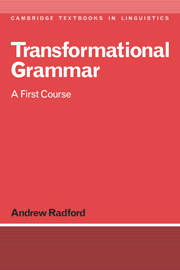8 - Transformations
Published online by Cambridge University Press: 05 June 2012
Summary
Overview
So far, we have been assuming that there is only one level of structure in syntax – that is, the level of S-structure which represents the superficial syntactic structure of sentences. And we have been assuming that the task of any adequate syntax of a language is to characterise (= generate) all the well-formed S-structures of the language. We have assumed that the class of well-formed S-structures in a given language will be determined by the Base of the Grammar, which comprises (i) a Categorial Component, and (ii) a Lexicon. The Categorial Component comprises a set of category-neutral X-bar rule schemas; the Lexicon specifies the categorial status and contextual restrictions associated with individual lexical items in a given language (e.g. the fact that an inherently transitive Verb such as devour cannot be used in an intransitive V-bar in which it lacks an NP complement).
In this chapter, however, we are going to argue that our existing model of Syntax is not adequate to handle certain characteristic constructions in natural languages, and that in order to provide a principled account of the syntax of these constructions, we need to posit an additional level of structure known as D-structure (corresponding to the level of Deep Structure in earlier models).
Information
- Type
- Chapter
- Information
- Transformational GrammarA First Course, pp. 401 - 461Publisher: Cambridge University PressPrint publication year: 1988
